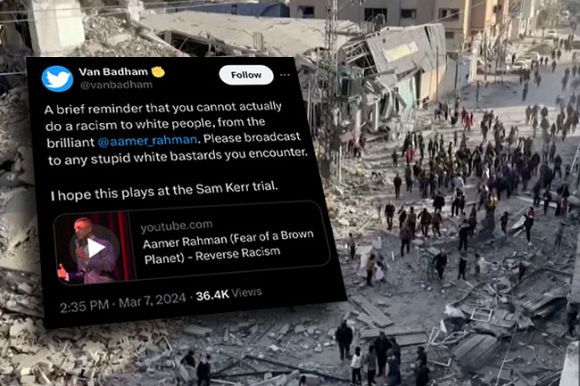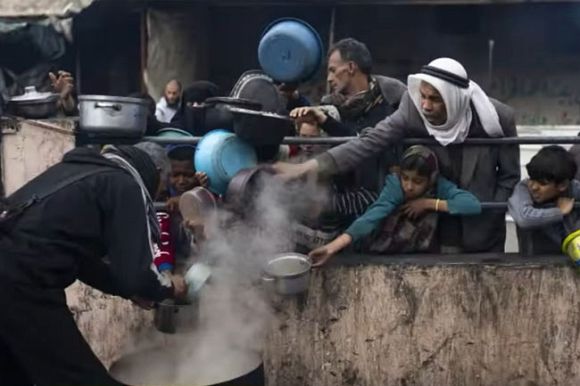This assessment by Dr Lee Duffield, the first of two reports for Independent Australia, studies the decades-old origins of the fighting in Gaza and the moral dilemmas it has generated.
THE KILLING of seven aid workers in an Israeli air attack, including Australian Zomi Frankcom, brought home to this country the full horrors of the war in Gaza.
Leaders normally sympathetic to Israel, including Australia’s Prime Minister Anthony Albanese, have had to discount claims by the Israeli Government that its forces “obviously” would not purposefully attack the bearers of humanitarian aid. They demanded a full and properly independent account of what happened. Trust has gone from the situation dominated by the radical Right-wing Prime Minister of Israel, Benjamin Netanyahu.
Several possibilities exist for why the free pass to travel was not honoured, including that this was another sign of gross failure of military discipline wrapped up in invidious politics. The Israeli state apparatus is heavily influenced, if not shot-through, with fanatics determined to subjugate the Arab population, using starvation as one weapon, sending their followers to blockade truck convoys at the city gates and angling to drive out the whole population — another Nakba.
The Israeli army is powerful but made up mostly of reservists; there have been errors, like the shooting of three hostages making an escape from their Arab captors. Who is to say the order to let the aid convoy go through was not obfuscated, shelved, contested, blocked or countermanded by extremist or resisting elements in the “system”?
Deeds like the killing of the aid workers on 1 April must be expected, though not accepted in this terrible moral dilemma — thousands of children and other civilians assaulted and done to death in a war zone, unable to escape, while the world watches astonished and ashamed.
History of bad blood
Grappling with it needs going back to the start with the declaration of a Jewish state in 1948. In the former Turkish colony, the Zionist settlers and migrants had more in common with the British administration they rebelled against, very violently, than with the actual colonised “natives” of the region, the Palestinian Arabs. Enmity grew from then.
In an example of the hostility that was bred, at the time of the September 11 2001 attack on New York, Jewish Americans or Israelis would tell you that the “West” might now understand “what they had to live with”, from “Arabs”.
The same contempt flowed from the other side, because of the Nakba — the driving-out of the Arab population, after losing to the Jewish forces in battle in 1948. They were pushed to the fringes of Palestinian territory, including the crowded refugee camps in Gaza — there to stay for over 70 years.
The climate of bitterness and distrust was ideal for radical or extremist foment on either side. “Hardline” Arabs resolved to “drive the Jews into the sea”; “hardline” Jews resolved to do much the same to the Palestinians. Successive efforts to reach détente and a settlement with a Palestinian state alongside Israel would be subverted by Islamist terror attacks, pounding reprisals and by also mobilisation of radical political movements — whether Likud in Israel with allied groups on the far Right, or Hamas.
Palestinians had nowhere to re-settle, even in the Arab world, coming under attack in Jordan (Black September 1970-71, in response to Palestinian terrorist groups mounting attacks from camps in Jordan) and Lebanon (Sabra and Shatila camps massacre 1982, committed by Lebanese rightist militias abetted by an Israeli occupation of the area).
Gaza by 2023 was a case of making the best of a very bad situation, while some might still be hoping and striving for a just peace.
The cities were built up, some industries like glasshouse horticulture and fishing, and Holy Land tourism developed; desalination plants provided water, not always very good; there was on-and-off electric power; you could go to the beach and watch local or international television; in an illusion of possible normalisation of relations, permits were arranged for 20,000 Palestinians to get work in Israel.
The United Nations, Islamic countries and other benefactor nations, and non-governmental organisations provided the schools, universities and hospitals that are now close to being all destroyed.
These organisations recruited workers from the community, hundreds now killed. Israel’s suspicions and the complaint that some of these employees joined the attack on 7 October caused the suspension at a crucial time of funding of the chief relief agency, United Nations Relief and Works Agency (UNRWA), by 18 donors; half, including Australia, have now reinstated that support, but not the main donor, USA.
Another dimension to this picture was provided by the radical Hamas party winning elections for a Palestinian Authority in 2006. It defeated the leftist and secular Fatah Administration that had become associated with corruption and unsuccessful efforts at making peace with the Israelis, as well as failure to run the garbage services and utilities — which Hamas promised to fix.
In office, Hamas conducted murderous purges of opponents and devoted money from Arab states to build up armed forces, especially short-range rockets, for bombarding Israeli territory. The rockets and bomb attacks on city commuters would be a show of “resistance” and symbolised an intention to “make Israel extinct”.
The attack on 7 October would be the same. There was no chance of mounting an actual invasion, of subjugating Israel using small arms and motorbikes. For objective, it was done as an act of defiance, a chance to capture useful hostages and inflict cruelties, and to get world sympathy if Israel made large-scale reprisals, affecting civilians. Could they have anticipated the scale of the military campaign that followed to systematically destroy them?
Outside observers could guess and wonder at the destabilising impacts, on society and on personalities, of intermittent warfare, over the years, with the rockets and terror bombings, and reprisals from Israel in the form of large-scale bombing in the densely populated zone. With hundreds of mosques in Gaza, would religion, notwithstanding its conflicts and distortions, be a force for bonding that community?
It would be confronted with a corrupted and despairing material world. Without security, very few jobs, the overcrowding and poor conditions of life, and the inability for most people to come and go from the territory, what chance of developing culture and building a strong society? There was a flag, but no country, trade and finance had to go through channels in Israel, which patrolled the borders — as was often said, a prison.
Most importantly for now, no matter what level of political support for Hamas, it was a community, civilians close in together, with brothers, fathers and sons in the Hamas army, literally underground in the tunnel defences — all extremely exposed if full-scale war would break out.
Pogrom on 7 October — sexual violence
That was the background to the ”fighters” who crossed into Israel on 7 October 2023. Lives exposed to deprivation, ugly rhetoric and violence would help explain, not excuse, the savagery and cowardice of the pogrom, the public rape, murder and abduction of innocents — 1,200 killed immediately and over 250 abducted.
What picture of such perpetrators: no culture, no mind or conscience, no love, driven by fear and hatred of women. Documentation of multiple rapes was assembled by journalists at the New York Times, whether because some were Jewish, as has been suggested, or not, certainly employing best journalistic practice; also by senior United Nations officials reporting to the Security Council, adding to thorough work done by Israeli media outlets.
The sexual violence is a lurid but crucial element in this story because of its obvious contribution to the vehemence of the punitive response that then came from Israel. It has been lurking in the background since the first Israeli army, the Haganah, outnumbered, astonishingly for the era, put their “girl soldiers” in the front line (notably in the elite Palmach formation).
That led to much sneering from the other side in the propaganda wars until the Israelis began to record their military victories. Female members of the Israel Defence Forces (IDF) over the decades have appeared to revel in their freedom, regularly featuring in calendar shoots.
It would be dishonest and bad analysis to play down the sexual violence in the October pogrom. Consider the motivating power of outrage, as when, even in the vale of civilisation, fathers of rape victims feel a frustrated duty to go to the courthouse and shoot the perpetrators. As it must be seen in Israel: in the present war, women and men in the IDF went to punish and exact retribution against the perpetrators.
Overwhelming — disproportionate and indiscriminate force?
Military action involves destroying the enemy. The IDF has deployed heavy weapons – tanks and air strikes – with the declared intention of “dismantling” all of the Hamas military units. More than 20,000 Palestinian civilians are known to have died and probably 10,000 Hamas soldiers; Israel counts the 1,200 Israelis killed on 7 October, several of the hostages and 600 troops.
David Remnick, astute editor of The New Yorker, recently described the conflagration as part of a reversal of peaceful worldwide trends towards ‘oppression and tragedy’, negating hopes of ‘decency, democracy and compromise’:
Israel was created precisely out of a sense that a tiny and persecuted population, following centuries of violence culminating in the Holocaust, could no longer endure the precarity of exile.
...the massacre of 7 October shattered the country’s sense of protection. At the same time, the Palestinians of Gaza, after years of Israeli siege and blockade, and immiserating misrule by Hamas, live in a state of excruciating loss and fear...
An article to follow reviews the conduct of the war focused on those prosecuting it and those paying the price, especially the political head, Benjamin Netanyahu, whose troops are hunting for Hamas commander Yahya Sinwar. And especially hostages and their families and the afflicted children of Gaza.
It registers international efforts to broker a settlement and asks: What chances for decency, democracy and compromise?
Amongst Dr Lee Duffield’s vast journalistic experience, he has served as ABC's European correspondent. He is also an esteemed academic and member of the editorial advisory board of Pacific Journalism Review.
Related Articles
- Albanese infirm over killing of Gaza aid workers
- Australia needs wartime government to confront global crises
- Australian media's greatest crime against Gaza is ignoring it
- What comes after Rafah
- EDITORIAL: What comes after Rafah
 This work is licensed under a Creative Commons Attribution-NonCommercial-NoDerivs 3.0 Australia License
This work is licensed under a Creative Commons Attribution-NonCommercial-NoDerivs 3.0 Australia License
Support independent journalism Subscribe to IA.
















